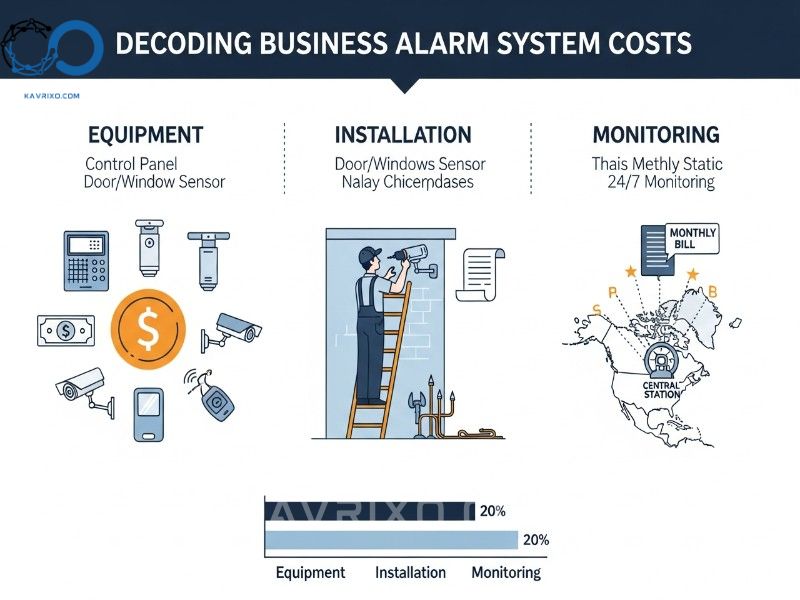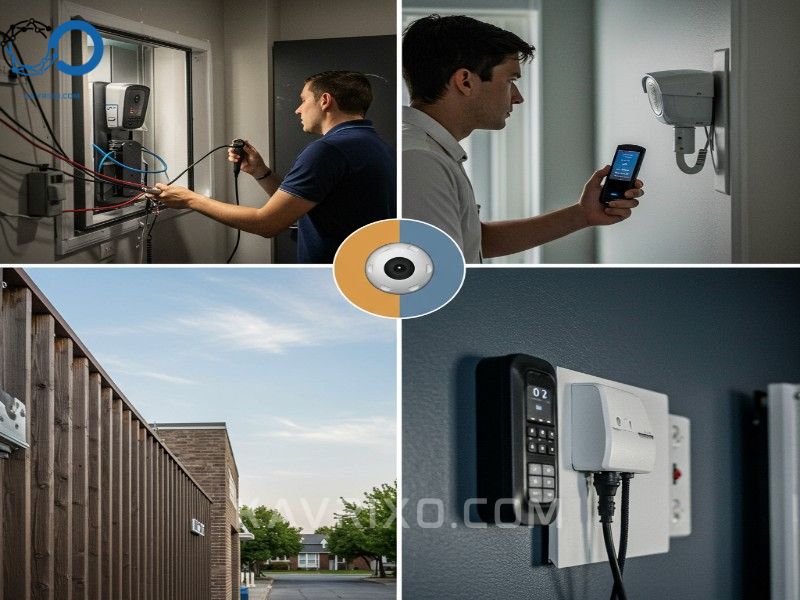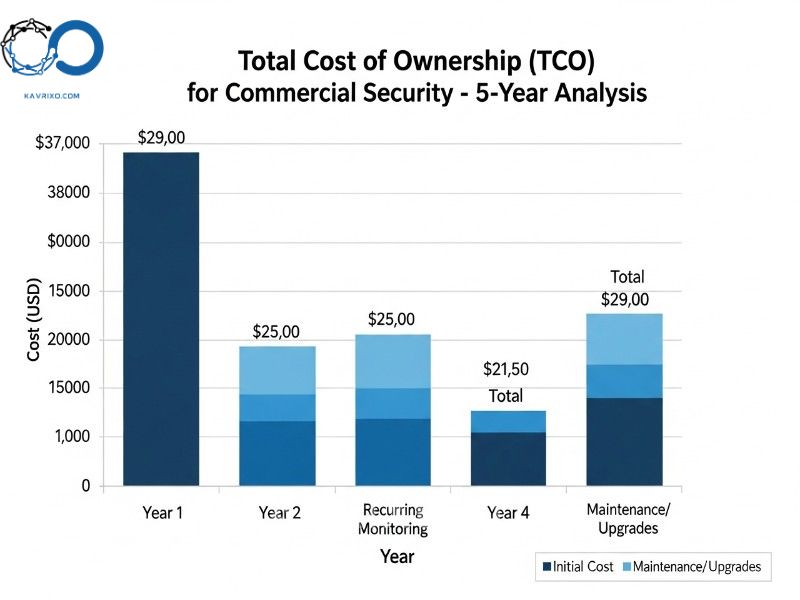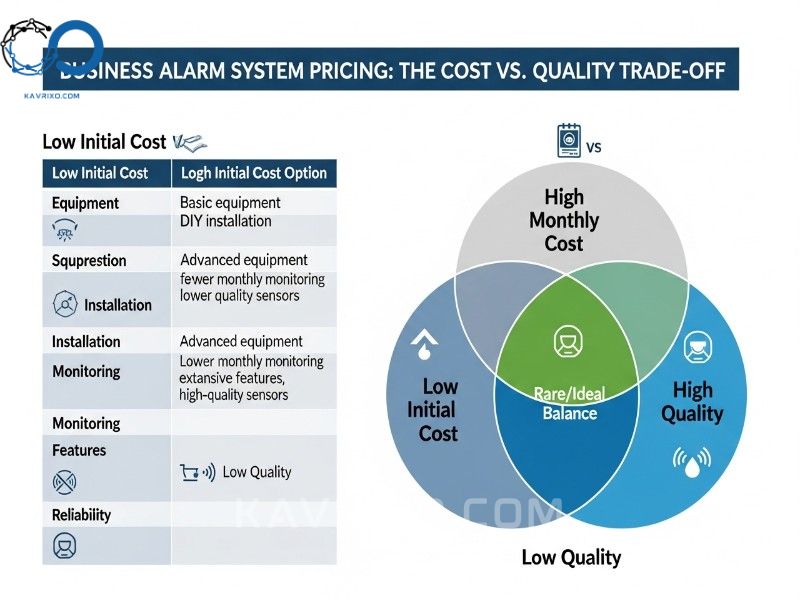Investing in a robust security infrastructure is non-negotiable for any successful enterprise. However, when owners and financial officers begin researching solutions, they quickly realize that obtaining transparent and standardized quotes for business alarm systems pricing is notoriously difficult. Unlike consumer electronics, commercial security costs are highly variable, dependent on facility size, operational complexity, risk profile, and the level of integration required.
This comprehensive guide is designed to peel back the layers of complexity surrounding commercial security system costs. We will detail the primary financial categories, explore the factors that drive price fluctuation, examine long-term expenses, and provide actionable strategies to help your business secure optimal value without compromising safety. Understanding the full picture—from initial investment to the total cost of ownership (TCO)—is essential for making an informed decision about protecting your assets, personnel, and data.
Contents
- 1 The Core Components of Business Security Costs
- 2 Factors That Significantly Influence Business Alarm Systems Pricing
- 3 Deep Dive into Equipment Costs: Packages vs. Custom Builds
- 4 Analyzing Ongoing Professional Monitoring Fees
- 5 Hidden Costs and Long-Term Financial Considerations
- 6 Strategies for Budgeting and Optimizing Business Alarm Systems Pricing
- 7 Conclusion: Making an Informed Investment in Commercial Security
The Core Components of Business Security Costs
When evaluating business alarm systems pricing, it is crucial to recognize that the final figure is not a single lump sum, but rather a combination of three distinct financial pillars: initial hardware, installation, and ongoing services.
Initial Equipment and Hardware Investment
This category represents the upfront cost of all physical components required for the security system to function. The quality, brand, and feature set of this equipment dramatically affect the initial investment.
For small to medium-sized businesses (SMBs), a basic package might include a central control panel, a few door/window sensors, and one or two interior motion detectors. However, larger or higher-risk operations require sophisticated hardware.
- Control Panel and Keypads: The central brain of the system. Advanced panels offer smart integration, cellular backup capabilities, and complex zone programming, raising the price point significantly.
- Intrusion Sensors: This includes magnetic contact sensors for doors and windows, and various types of motion detectors (PIR, dual-tech, glass break). The sheer quantity needed for a large facility drives the equipment cost up.
- Video Surveillance (CCTV/IP Cameras): Camera costs vary based on resolution (4K vs. 1080p), storage capacity (NVR/DVR), field of view, and advanced features like night vision, thermal imaging, or built-in video analytics. High-end, commercial-grade cameras are a substantial part of the overall security equipment package cost.
- Perimeter Security: Specialized outdoor sensors, electric fence monitoring, or ground radar systems are necessary for properties requiring strong exterior protection, adding significant cost and complexity.
It is important to determine whether the equipment is proprietary (only works with the provider’s monitoring services) or open-source, as this impacts long-term flexibility and upgrade paths.
Professional Installation Expenses
While some basic DIY kits exist for very small offices, commercial security systems almost universally require professional installation. These services involve labor, configuration, system testing, and integration with existing network infrastructure.
Installation costs are driven by several key factors:
- Complexity of Wiring: Wired systems require technicians to run extensive cabling through walls, ceilings, and conduits. This labor is intensive and expensive, especially in older buildings or facilities that require hidden wiring for aesthetic purposes.
- Integration Requirements: If the alarm system needs to interface with access control systems (key card readers), fire suppression systems, or building management software, the programming and integration labor costs will increase.
- Facility Size and Accessibility: Installing sensors and cameras across a sprawling warehouse or multi-story office building takes substantially longer than securing a single storefront. Difficult-to-reach areas often necessitate specialized lift equipment or additional technicians.
Typically, installation fees range from 10% to 50% of the total hardware cost, though some providers offer “free installation” models where the cost is simply amortized and hidden within higher recurring monthly monitoring fees. Buyers must scrutinize the contract to understand this trade-off.
Ongoing Monitoring and Subscription Fees
The most consistent and predictable element of business alarm systems pricing is the recurring monitoring fee. This is the fee paid to a central station that receives signals from your system 24/7/365 and dispatches authorities or contacts keyholders when an incident occurs.
These fees generally cover:
- Central Station Service: The operational cost of staffing and maintaining the monitoring center.
- Communication Pathway: Ensuring reliable communication between the alarm panel and the monitoring station (often cellular backup).
- Software Licensing and Maintenance: Access to management portals, mobile apps, and necessary software updates.
Monthly monitoring costs for a basic commercial setup usually start around $40 to $60, but can escalate sharply—often exceeding $200 to $500 per month—for highly complex systems requiring advanced video verification, dedicated IT support, or managed security services.

Factors That Significantly Influence Business Alarm Systems Pricing
The wide variance in commercial security system costs stems from tailored solutions designed to meet highly specific business needs and risk profiles. Generic pricing rarely applies.
Scale and Complexity of the Business Environment
The size and layout of the premises are the most immediate cost drivers.
- Small Offices and Retail (Under 2,000 sq. ft.): These environments often utilize standardized packages with minimal sensors. Pricing is relatively low and predictable, focused primarily on intrusion detection and basic video. Total upfront costs might range from $800 to $3,000.
- Mid-Sized Commercial Facilities (5,000–20,000 sq. ft.): Requirements increase significantly here, necessitating multiple zones, sophisticated access control for employee entry points, and extensive camera coverage. This complexity pushes initial outlay into the $5,000 to $15,000 range, depending on equipment quality.
- Large Industrial or Enterprise Campuses: Facilities like manufacturing plants, data centers, or large educational institutions require enterprise-level systems. These systems often involve thousands of feet of cable, specialized environmental sensors (temperature, water), integrated access control across dozens of doors, and dedicated security operations centers. Upfront costs can easily exceed $50,000, factoring in robust infrastructure and software licensing.
Technology Choices: Wired vs. Wireless Systems
The choice between wired and wireless connectivity impacts both installation difficulty and long-term maintenance.
- Wired Systems: Highly reliable and less prone to signal interference or battery failure. However, installation is invasive, time-consuming, and expensive due to the labor involved in running physical connections. This choice is often preferred for new construction or larger facilities where reliability is paramount.
- Wireless Systems: Installation is much faster and cheaper as it requires minimal wiring. Equipment, however, can sometimes be more expensive than its wired counterpart, and the ongoing operational cost includes regular battery replacements for sensors. Wireless is ideal for leased spaces or historical buildings where running wires is impractical. Hybrid systems, which utilize both technologies, are increasingly common, offering a balance of reliability and flexible installation.
Level of Integration and Customization
Modern security systems are rarely standalone alarms; they are integrated ecosystems. The more systems you connect, the higher the business alarm systems pricing becomes.
- Access Control: Integrating badge readers, biometric scanners, and electronic locks across multiple doors requires dedicated hardware, network infrastructure, and specialized software licenses.
- Environmental Monitoring: Adding detection for flood, temperature changes, server room conditions, or hazardous materials increases sensor costs and often requires higher-tier monitoring services.
- Video Verification and AI: Systems that use artificial intelligence (AI) to filter out false alarms, identify vehicles, or perform complex facial recognition require powerful processors (either edge devices or cloud services), leading to higher hardware and subscription costs.
Contract Length and Provider Reputation
Security contracts typically span 36, 48, or 60 months. Longer contracts often result in lower upfront installation or equipment costs, as the provider recoups their investment over a longer commitment period. Conversely, short-term or month-to-month contracts usually require the business to pay for all equipment and installation upfront.
Furthermore, providers with established reputations, high-level certifications (like UL listed monitoring stations), and robust customer support infrastructure often charge a premium for their services, reflecting the reliability and quality assurance they offer.

Deep Dive into Equipment Costs: Packages vs. Custom Builds
Understanding how security providers structure their equipment offerings is key to controlling initial expenditure.
Standard Security Equipment Packages (SMB Focus)
Many providers offer tiered packages designed for common business footprints (e.g., “Bronze Retail Package,” “Silver Office Package”).
- Pros: Predictable, often includes discounted or free installation, and simplifies the decision-making process.
- Cons: Limited customization. If your business has unique vulnerabilities (e.g., a vault, a specific loading dock configuration), the standard package may not provide adequate coverage, forcing costly add-ons later.
A typical mid-range package for a small business might cost between $1,500 and $4,000 for equipment, provided the monitoring contract is signed for five years.
Specialized Equipment and Advanced Features
When systems require advanced protection, costs skyrocket due to specialized components:
- High-End IP Cameras: Cameras with panoramic views, motorized zoom, or those hardened for extreme outdoor weather (IP66/67 ratings).
- Biometric Access Control: Fingerprint readers, retina scanners, or vein scanners, which are significantly more expensive than standard proximity card readers.
- Video Management Software (VMS): Proprietary software licenses for managing hundreds of cameras across multiple locations, often billed annually per camera or per server.
- Redundancy and Failover: Equipment designed with backup power, redundant servers, and multiple communication paths to ensure zero downtime—crucial for critical infrastructure.
Understanding Total Cost of Ownership (TCO)
Focusing solely on the initial business alarm systems pricing is a common mistake. The true financial commitment is revealed by calculating the Total Cost of Ownership (TCO) over a typical 5- to 7-year lifespan.
TCO includes:
$$TCO = (Initial\ Equipment\ Cost) + (Installation\ Fee) + (Monitoring\ Fees \times Contract\ Length) + (Maintenance\ & \ Upgrade\ Budget)$$
A system with a low upfront cost but high monthly monitoring fees and cheap, unreliable components that require frequent replacement may ultimately be more expensive than a higher-quality system with a large initial outlay but lower long-term operational costs. Analyzing TCO helps businesses budget realistically and avoid financial surprises down the line.

Analyzing Ongoing Professional Monitoring Fees
The recurring subscription is the lifeblood of the security industry and a mandatory component of professional commercial security system costs. The price depends heavily on the level of service provided.
Levels of Monitoring Service
- Standard Alarm Monitoring: Basic service where the central station receives intrusion or fire alerts and follows a protocol (call keyholder, dispatch police/fire). This is the baseline offering.
- Video Verification Monitoring: When an alarm triggers, the monitoring station technician remotely accesses the corresponding camera feed to confirm a genuine threat before dispatching authorities. This significantly reduces false alarms and is often preferred by law enforcement, leading to faster response times. This service carries a higher monthly premium.
- Managed Security Services: For large enterprises, this includes monitoring, remote system health checks, cybersecurity monitoring (if integrated), and often remote patching and maintenance. This is the most expensive tier, essentially outsourcing the entire security management function.
Communication Methods
How the alarm signal reaches the monitoring center affects both reliability and cost.
- Landline (POTS): Cheapest, but highly vulnerable to being cut, unreliable, and increasingly phased out.
- IP/Internet: Uses the existing internet connection. Cost-effective but reliant on stable power and network connectivity.
- Cellular Backup: The industry standard for commercial security. A dedicated cellular communicator ensures the system remains connected even if phone lines are cut or power is lost. Cellular service is generally included in the monitoring fee, and the reliability justifies the cost.
- Dual-Path: Utilizing both IP and Cellular pathways simultaneously, offering maximum redundancy. This is the most secure and therefore the highest-priced communication method.
False Alarm Mitigation and Associated Costs
False alarms are a major nuisance and can incur financial penalties. Many municipalities charge escalating fines for excessive false alarms, which contribute indirectly to the overall business alarm systems pricing.
Providers offering advanced features like video verification or specialized intelligent sensors (that can differentiate pets from intruders, or wind from forced entry) help mitigate these fines. While these systems have higher upfront costs or monitoring fees, the long-term savings from avoiding municipal penalties can offset the expense. Businesses should inquire about their provider’s false alarm guarantee and mitigation strategies.
Hidden Costs and Long-Term Financial Considerations
A thorough financial analysis of security must look beyond the quoted initial price and monthly fee. Several less obvious costs can impact the long-term financial viability of the system.
Maintenance, Repairs, and Upgrades
Security systems, like all technology, require upkeep.
- Warranties: Equipment warranties typically last 1-3 years. After the warranty expires, repair costs (technician labor plus parts) fall to the business.
- Service Contracts: Many providers offer extended maintenance plans that cover parts and labor for a fixed monthly fee. While adding to the recurring expense, these contracts provide budget predictability and ensure timely repairs.
- System Upgrades: Technology evolves rapidly. A system purchased today may require significant software or hardware upgrades within five years, especially to maintain compatibility with new operating systems or networking standards. Budgeting for these refresh cycles is crucial for maintaining effective security.
Licensing, Permits, and Insurance Premium Adjustments
Local regulations often dictate requirements that add to the cost:
- Alarm Permits: Most cities require businesses to register their alarm systems and pay an annual permit fee (usually $20–$150). Failure to obtain a permit can result in higher fines for false alarms.
- Insurance Savings: Conversely, one of the few financial benefits is potential savings on commercial property insurance. Insurers typically offer discounts (ranging from 5% to 20%) for professionally installed and monitored security and fire systems. This discount should be factored into the overall financial analysis, as it effectively reduces the net business alarm systems pricing.
Lease vs. Purchase: Financial Implications
Businesses face a critical choice regarding the equipment: purchase it outright or lease it through the security provider.
- Purchasing: High initial cost, but the business owns the equipment free and clear. This offers flexibility in choosing monitoring providers later and ensures the business retains the asset value.
- Leasing/Financing: Low or zero upfront cost. The equipment is bundled into the monthly fee over the contract term (e.g., 60 months). This is attractive for businesses conserving capital. However, the total cost over the lease term is often higher than the purchase price, and the business typically does not own the equipment until the contract is fulfilled, often requiring expensive buyout options.

Strategies for Budgeting and Optimizing Business Alarm Systems Pricing
Navigating the complexities of commercial security costs requires a strategic, risk-based approach rather than simply seeking the cheapest quote.
Conducting a Thorough Risk Assessment
Before obtaining quotes, the business must clearly define its security needs and risk profile. A professional risk assessment should identify:
- Critical Assets: What needs protection (inventory, data servers, specific personnel)?
- Vulnerability Gaps: Where are the weakest points of entry or failure (windows, back doors, roof access)?
- Regulatory Requirements: Are there specific compliance needs (e.g., HIPAA, PCI DSS) that mandate certain system features (audit logs, specific retention periods)?
A detailed assessment prevents overspending on unnecessary features while ensuring critical gaps are covered. This ensures that every dollar spent contributes directly to mitigating identified risks.
Negotiating Equipment and Installation Rates
Because business alarm systems pricing is highly customized, negotiation is often possible, especially on the upfront costs.
- Bulk Purchase Discounts: If you are securing multiple locations or committing to a long contract, leverage this scale to negotiate lower per-unit costs for cameras and sensors.
- Installation Timing: Scheduling installation during off-peak hours (nights or weekends) might sometimes incur an extra fee, but asking for flexibility during the provider’s slow periods could lead to a small discount on labor.
- Use Existing Infrastructure: If your facility already has existing wiring (for old CCTV or network drops), inquire how the installer plans to reuse this infrastructure. This can significantly reduce labor time and material costs.
Comparing Quotes: Focus on Value, Not Just Price
When comparing proposals from multiple vendors, avoid the trap of comparing only the bottom-line cost. A proposal that costs $5,000 less might use inferior equipment that fails prematurely or offers a monitoring response time that is too slow for your operational needs.
Key comparative metrics should include:
| Metric | Low Price Option (Caution) | Value-Optimized Option (Recommended) |
| Equipment Quality | Generic, non-brand components, basic resolution. | Commercial-grade, recognized brands (e.g., Axis, Honeywell), high resolution. |
| Monitoring Response | Average 60-90 second response; no video verification. | Average 30-45 second response; includes video verification. |
| Warranty/Service | 1-year parts warranty; high hourly service rates after warranty. | 3-5 year warranty; optional comprehensive maintenance contract. |
| Communication | IP only (vulnerable to power/internet failure). | Dual-path (Cellular + IP) for redundancy. |

Conclusion: Making an Informed Investment in Commercial Security
Determining the precise business alarm systems pricing for your company is a complex undertaking, requiring careful consideration of hardware quality, installation complexity, and long-term service agreements. While initial expenses can range dramatically—from a few thousand dollars for a basic SMB setup to hundreds of thousands for a large, integrated enterprise solution—the true measure of value lies in the Total Cost of Ownership and the system’s effectiveness in mitigating your specific risks.
Security is not an area where cutting critical corners is advisable. By conducting a detailed risk assessment, seeking transparent TCO analysis from prospective providers, and negotiating strategically on equipment and installation, your business can acquire a resilient, state-of-the-art security system that delivers maximum protection and peace of mind for years to come.

